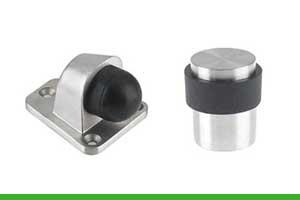How to fit a door stop

Perhaps you own a high-traffic commercial building and require doorstops to prevent dents and scuff marks on the walls or simply need a doorstop because you’re tired of repairing holes in walls punched in by door handles. This guide will help you fit a door stop in no time.
We stock many types of door stops, from door wedges to skirting door stops and floor door stops. Door wedges are mainly placed in front of doors to hold them open, while skirting door stops and floor door stops are used to prevent doors from swinging too widely, being placed behind the door.

For commercial use, we’d highly recommend our bestselling doorstop, the heavy-duty floor mounted door stop. This door stop is also suitable for residential use. This oversized floor mounted door stop is made from solid investment casting and it features a satin stainless-steel finish, as well as a threaded ball end rubber insert.

Follow our guide below for instructions on how to fit a floor mounted door stop.
Materials
- Doorstop
- Screwdriver
- Pencil or masking tape
Firstly, choose the location for the door stop. Open the door until it’s parallel with the wall and position the door stop down, not to close to the end of the door and not too far away.
Once you’ve chosen the right spot, use a pencil (or masking tape if your floors are carpeted) to mark the floor.
Place the doorstop inside the line you’ve marked. Finally, use a screwdriver to fasten the screws in the doorstop screw holes – and you’re done, no more scuffed walls.

We hope that you have enjoyed this guide and that it has been helpful. In case you have any enquiries regarding our ironmongery products, feel free to contact our friendly team on 01376 557 561 or email us at info@ironmongeryexperts.co.uk.
Disclaimer
At Ironmongery Experts we strongly advise that you always take safety precautions into consideration when undertaking a DIY project. We also strongly suggest that you closely read and follow the instructions provided by the manufacturer of any building materials, products or tools you use for your projects.
We try our best to provide clear and correct instructions within our articles, so you can easily complete any DIY project you desire. However, please note that the information we provide should only be used as a guideline and that some information within the text may not be entirely accurate.
When using our articles for information and advice, please note that is your own responsibility to determine your capabilities when undertaking and executing the task you wish to complete.
Before starting a DIY task, we strongly recommend that you educate yourself of any existing building, gas, water and electrical works regulations. We believe it is in your best interest to complete further research and/or contact the necessary professional body should you have any further concerns.
We also strongly recommend that a qualified tradesperson completes the relevant safety tests and checks on any DIY you have completed.